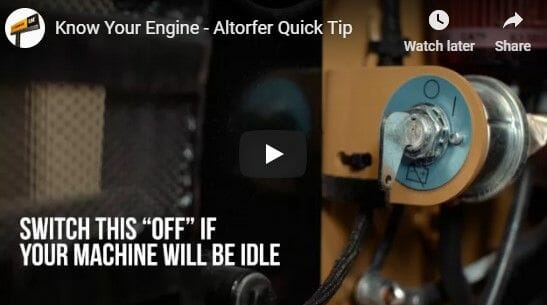- EQUIPMENT
- ATTACHMENTS
- POWER SYSTEMS
- TECHNOLOGY
- AGRICULTURE
December 27, 2018

To make sure your Caterpillar® equipment is up and running when you need it to work, it’s always a good idea to know the engine inside of it. By acquainting yourself with some of the major components located inside your engine bay, you’ll go a long way toward ensuring your engine runs efficiently. In addition, by conducting regular checks on the engine’s vital parts and fluids, you’ll also help extend the life of your machine.
Watch the following quick tip video as a representative from Caterpillar gives you an overview of a Cat engine and the components that help keep it in peak condition.
Hey, I’m Dave and this is today’s quick tip.
Keep your engine running at maximum efficiency by knowing a few simple things about the important components of your engine bay.
First, know the location of your engine oil dip stick.
Check the oil level often and make sure the engine contains the proper level of oil.
Air filters are one of the most vital components of the engine bay.
Clean air going in will lengthen the life expectancy of your engine, so make sure to check your filter daily.
This is what the fuel filter looks like.
It’s important to keep an eye on your fuel condition.
Visually inspecting the fuel will let you know if you have high amounts of water or contaminants.
Excess water leads the fuel gelling in cold weather and to rough idling.
Here is what the hydraulic filter looks like.
Be sure to follow your machine models recommended intervals for changing the hydraulic filter.
Here is the site glass for checking coolant levels.
Make sure your coolant is filled according to spec.
The coolant overfill jug looks like this.
Visually inspect the overfill jug, so you know that it’s at the right level.
The block heater is located here.
The block heater can be plugged in during colder weather. This will keep your coolant warmed up to help the engine upon cold starts.
This is the battery disconnect switch.
If your machine is equipped with a battery disconnect switch, it is generally located in this area.
Manually disconnecting the battery is helpful as an anti-theft device or if the machine will sit idle for an extended period of time.
The fuel fill on newer models is located inside the engine bay.
It is important to distinguish between your fuel fill and your hydraulic oil fill.
On newer models, these two have been switched.
They are now color-coded and labeled to help prevent incorrect filling.
On newer models, here is what the hydraulic oil fill and labeling look like.
This shows you the level of hydraulic oil.
Make sure it’s filled according to spec.
That’s a look inside your engine bay.
Proper maintenance of these components will help keep you on the job and keep your engine running at top performance.
As always, consult your operation and maintenance manual for more information.
That was today’s quick tip, and thanks for watching.
This instructional video can serve as training for new operators or as part of a refresher course for existing personnel. This video shows operators how to check on their engine’s filters and fluids, as well as how to top them off properly.
In addition, it covers extra features built into the machine in order to support its smooth operation in specific conditions like cold weather.
Of course, there’s probably nothing more important to an engine’s continued performance than making sure it has enough oil. That’s why you want to acquaint yourself with the location of your engine oil dipstick. Be sure to check it often in order to keep a proper level of oil in your engine.
Keeping an eye on your engine’s primary three filters — air, fuel and hydraulic — comes next. For your engine to have a long life, it must have a continuously clean supply of air, so locating and checking your engine’s air filter should be part of your daily engine check. After that, it’s wise to locate your fuel filter in order to check on the condition of your fuel. Conducting a visual inspection of your fuel can help you spot signs of excess water and contaminants. It’s also recommended to regularly check your hydraulic filter and follow your model’s instructions for fluid levels and changes.
Finally, pay special attention to the locations of your fuel fill and hydraulic oil fill, as well as the differences between them. On newer models, these are easily distinguished thanks to color coding and labeling. And for further engine information, it’s advisable to refer to your operation and maintenance manual.
Even world-class engines need ongoing maintenance, parts and repairs. Our Altorfer Equipment Management Solutions — EMSolutions — enable you to set up a comprehensive maintenance and repair plan for your entire fleet. We offer S.O.S. Fluid Analysis, which analyzes the state of your oil, coolant and diesel fuel. In addition, we use state-of-the-art tools such as Vision Link and Product Link to remotely monitor your fleet so you know how it’s performing in real-time.
At Altorfer CAT, we’re proud to have been serving the heavy machinery needs of companies in construction, mining, forestry, agriculture and many more industries since 1957. Currently, we have 23 locations in 18 cities across Eastern Iowa, Central Illinois and Northern Missouri. For quality equipment, parts and service, contact us or call 800-333-5993 today!